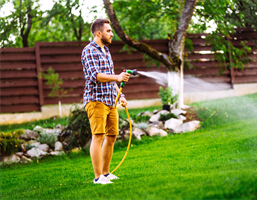
How to have the best lawn on the block this spring
Winter weather plus Canadian lawns, equals a spring refresh. Proper care as the warmer weather approaches will bring your green space back to life. Here are some simple tips to ensure your lawn is the best on the block this spring.
Clean up
Out with the old, in with the new. Gather and discard all the old, dead foliage and debris that appeared in your yard over winter so there’s fresh space to grow.
Aerate the soil
Aerating means puncturing holes in your lawn so water, air and nutrients can reach the roots. It’s best to aerate when your grass is in its peak growing season so it can recover quickly – think early spring. If you have high-traffic areas or heavy clay soil, you will want to aerate every year. If you have sandy soil or your lawn is growing well, you can aerate every two to three years. Check your local hardware store, such as The Home Depot, for tool rental options.
De-thatch
Thatch is a layer of living and dead grass, stems and roots that form between the green grass and the soil surface. Some thatch is helpful – it conserves ground moisture, cushions turf and insulates the soil from extreme temperatures. But too much thatch can repel water, dry up roots and provide cover for unwanted insects. If your thatch layer is more than two centimetres (three-quarters of an inch) thick, it’s time to de-thatch your lawn so air, water, nutrients and fertilizer can reach the soil better, and it can drain more effectively.
Overseed
Extra seeding can repair bare patches and create a thick lawn that crowds out weeds, insects and disease. The best time to overseed your lawn is mid-April to mid-May. Purchase grass seed appropriate for the conditions you’re growing in, such as an all-purpose blend for a lawn that receives an average amount of sun. Lightly rake the soil to create seed-soil contact, but don’t cover the grass seed or it won’t sprout.
Water frequently
Lastly, grass seeds need direct sunlight and regular moisture to begin to sprout, which can take up to three weeks. Be vigilant and water the seed daily, ensuring it stays moist but not wet. Once you start to see the grass seed begin to sprout you should begin to cut back on watering. Water new and established lawns early in the morning to avoid losing any moisture to evaporation. Also, avoid watering at night – your lawn will likely stay wet, providing an ideal environment for disease. Once your lawn is established, water deeply (unless it has rained) with at least two to three centimetres (one inch) of water per week to encourage healthy roots.
credit -newscanada

Leave A Comment
You must be logged in to post a comment.